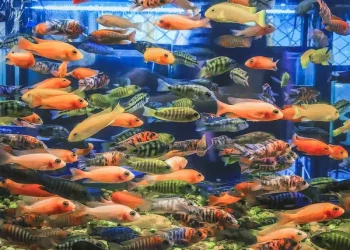Lungfish, with their unique ability to survive in both aquatic and terrestrial environments, have long intrigued scientists and nature enthusiasts alike. These ancient fish, known for their lung-like structures that enable them to breathe air, possess remarkable adaptations that have allowed them to persist for millions of years. One common question that arises is, “How long can lungfish live underwater?” In this article, we delve into the fascinating world of lungfish, exploring their biology, behavior, and the factors that influence their underwater survival.
Adaptive Features of Lungfish
Lungfish belong to the family Dipnoi, which includes six extant species distributed across Africa, South America, and Australia. Their evolutionary history dates back to the Devonian period, making them one of the oldest living vertebrate lineages. One of the most remarkable features of lungfish is their ability to breathe air using lungs, allowing them to survive in oxygen-depleted aquatic environments.
Lungfish have evolved a unique combination of gills and lungs, allowing them to extract oxygen from both water and air. While underwater, they primarily use their gills to extract dissolved oxygen from the water, much like other fish. However, when oxygen levels are low or water conditions deteriorate, lungfish can come to the water’s surface to gulp air into their lungs. This ability to supplement their oxygen intake from both sources is a key factor in their adaptability and survival.
Underwater Survival Duration
The duration lungfish can stay underwater varies among species and environmental conditions. African lungfish (Protopterus spp.) and South American lungfish (Lepidosiren paradoxa) are the two primary genera of lungfish that exhibit distinct behaviors and adaptations.
African lungfish are known for their remarkable ability to survive extended periods of drought. When their aquatic habitats dry up, they can burrow into the mud and estivate (a form of dormancy) until water becomes available again. During estivation, African lungfish can remain buried for several years without access to water. Their metabolic rate decreases significantly during this time, allowing them to conserve energy and survive using stored fat reserves. Once the rainy season returns and water returns to their habitat, they can rehydrate and resume their normal activities.
South American lungfish, on the other hand, are found in environments with more consistent water availability. They are less adapted to drought survival compared to their African counterparts. However, they still possess the ability to breathe air using their lungs, which allows them to cope with fluctuating oxygen levels in their aquatic habitats.
Factors Influencing Underwater Survival
Several factors influence how long lungfish can live underwater:
Species and Location: Different species of lungfish have evolved in diverse environments, which affects their adaptations and survival strategies. African lungfish have evolved to survive in arid regions with fluctuating water availability, while South American lungfish inhabit more stable aquatic environments.
Habitat Conditions: Water quality, temperature, dissolved oxygen levels, and overall habitat health impact lungfish’s ability to survive underwater. Poor water quality or low oxygen levels can prompt lungfish to seek air more frequently.
Metabolic Rate: Lungfish can adjust their metabolic rate based on environmental conditions. During periods of lower oxygen availability, they can slow down their metabolic processes to conserve energy.
Burrowing and Estivation: African lungfish’s unique ability to estivate by burrowing into the mud during droughts greatly extends their underwater survival duration.
Conclusion
The duration lungfish can live underwater varies among species and environmental conditions. African lungfish, renowned for their exceptional drought survival abilities, can remain buried in mud for several years during estivation. South American lungfish also possess adaptations that allow them to cope with fluctuating oxygen levels, although they are less adapted to extended drought survival compared to their African counterparts. Factors such as species, habitat conditions, metabolic rate, and burrowing behaviors all influence how long lungfish can remain underwater.
Lungfish’s ability to switch between aquatic and aerial respiration highlights their remarkable adaptability and evolutionary success. Their survival strategies offer valuable insights into the diverse ways in which organisms can adapt to challenging environments. As we continue to explore the mysteries of these ancient fish, we gain a deeper appreciation for the intricate interplay between biology, behavior, and the ever-changing natural world.
Related Topics:


























